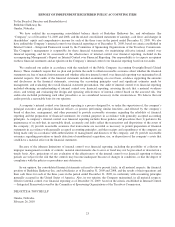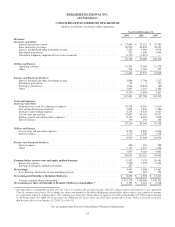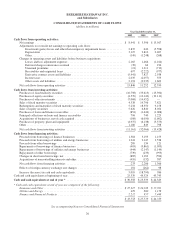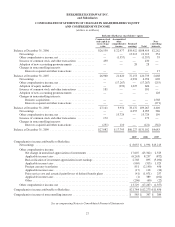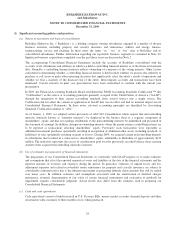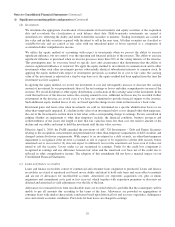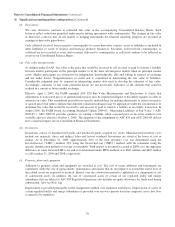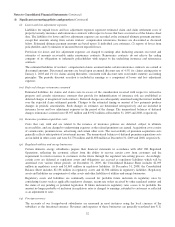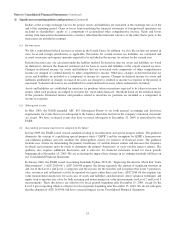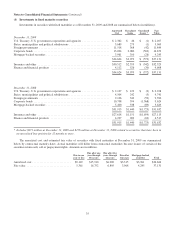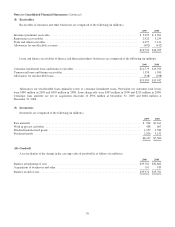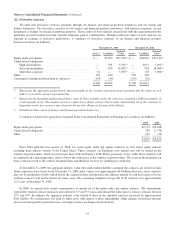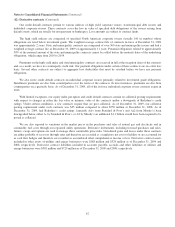Berkshire Hathaway 2009 Annual Report Download - page 35
Download and view the complete annual report
Please find page 35 of the 2009 Berkshire Hathaway annual report below. You can navigate through the pages in the report by either clicking on the pages listed below, or by using the keyword search tool below to find specific information within the annual report.Notes to Consolidated Financial Statements (Continued)
(1) Significant accounting policies and practices (Continued)
Dollars at the average exchange rate for the period. Assets and liabilities are translated at the exchange rate as of the
end of the reporting period. Gains or losses from translating the financial statements of foreign-based operations are
included in shareholders’ equity as a component of accumulated other comprehensive income. Gains and losses
arising from transactions denominated in a currency other than the functional currency of the entity that is party to the
transaction are included in earnings.
(r) Income taxes
We file a consolidated federal income tax return in the United States. In addition, we also file income tax returns in
state, local and foreign jurisdictions as applicable. Provisions for current income tax liabilities are calculated and
accrued on income and expense amounts expected to be included in the income tax returns for the current year.
Deferred income taxes are calculated under the liability method. Deferred income tax assets and liabilities are based
on differences between the financial statement and tax basis of assets and liabilities at the current enacted tax rates.
Changes in deferred income tax assets and liabilities that are associated with components of other comprehensive
income are charged or credited directly to other comprehensive income. Otherwise, changes in deferred income tax
assets and liabilities are included as a component of income tax expense. Changes in deferred income tax assets and
liabilities attributable to changes in enacted tax rates are charged or credited to income tax expense in the period of
enactment. Valuation allowances are established for certain deferred tax assets where realization is not likely.
Assets and liabilities are established for uncertain tax positions taken or positions expected to be taken in income tax
returns when such positions are judged to not meet the “more-likely-than-not” threshold based on the technical merits
of the positions. Estimated interest and penalties related to uncertain tax positions are included as a component of
income tax expense.
(s) Subsequent events
In May 2009, the FASB amended ASC 855 Subsequent Events to set forth general accounting and disclosure
requirements for events that occur subsequent to the balance sheet date but before the company’s financial statements
are issued. We have evaluated events that have occurred subsequent to December 31, 2009 as prescribed by the
FASB.
(t) Accounting pronouncements to be adopted in the future
In June 2009, the FASB issued revised standards relating to securitizations and special-purpose entities. The guidance
eliminates the concept of a qualifying special-purpose entity (“QSPE”) and the exemption for QSPE’s from previous
consolidation guidance and also modifies the derecognition criteria for transfers of financial assets. The guidance
includes new criteria for determining the primary beneficiary of variable interest entities and increases the frequency
in which reassessments must be made to determine the primary beneficiary of such variable interest entities. The
guidance also requires additional disclosures and is effective for financial statements issued for fiscal periods
beginning after November 15, 2009. We are evaluating the impact these changes in accounting standards will have on
our Consolidated Financial Statements.
In January 2010, the FASB issued Accounting Standards Update 2010-06, “Improving Disclosures About Fair Value
Measurements” (“ASU 2010-06”). ASU 2010-06 requires disclosing separately the amount of significant transfers in
and out of the Level 1 and Level 2 categories and the reasons for the transfers and it requires that Level 3 purchases,
sales, issuances and settlements activity be reported on a gross rather than a net basis. ASU 2010-06 also requires fair
value measurement disclosures for each class of assets and liabilities and disclosures about valuation techniques and
inputs used to measure fair value for both recurring and nonrecurring fair value measurements for Level 2 and Level 3
measurements. These disclosures are effective for fiscal periods beginning after December 15, 2009, except for the
Level 3 gross reporting which is effective for fiscal periods beginning after December 15, 2010. We do not anticipate
that the adoption of ASU 2010-06 will have a material impact on our Consolidated Financial Statements.
33


